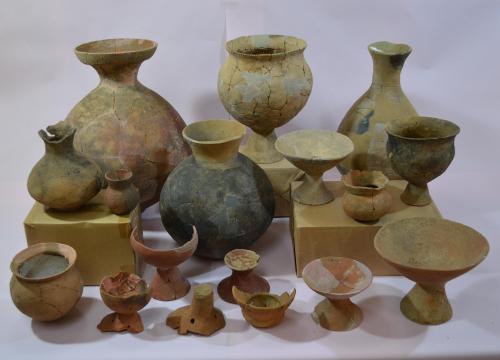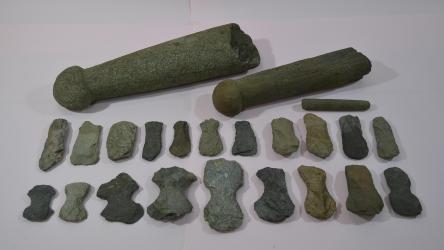Items excavated from Hiraodaihara ruins
Updated: October 29, 2018

Earthenware from the Yayoi period to the early Kofun period
Hiraodaihara Ruins Overview
On the lower plateau to the north of Hirao House Hiraodaihara Ruins There were three between 1977 and 1978. Excavations was carried out, Ruins The contents have been revealed. Ruins In the era of Jomon period from, Yayoi period , Kofun period , Nara period It was operated for a very long period of time. Complex ruins It was discovered Remains of a pit dwelling teeth, Jomon period 9 houses, Yayoi period from Kofun period First 22 houses, Kofun period From the latter period Nara period 7 houses, totaling 38 houses. Yayoi period From the end Kofun period In the early period Square moat tomb Five have been discovered. Ruins The features of Yayoi period from Kofun period In the early period Village ruins and Grave site The discovery of Yayoi period ruins These were the discoveries. Remains From each era, Earthenware or Stone tools etc. in large quantities Excavated However, there were some particularly important Excavated items 175 items have been designated as Inagi City tangible cultural properties.
Jomon Period Materials
Specified Jomon period The materials are Earthenware and Stone tools is. Earthenware So Jomon period Early, middle and late Deep bowl-shaped pottery 5 points, Shallow pottery 1 point, Spouted Pottery 1 piece, miniature Earthenware 2 points, Earthen products There are 6 items. Deep bowl-shaped pottery teeth Cooking Used for Earthenware And one of them is early Pointed-bottom pottery is. Spouted Pottery is a tool used to pour liquids such as sake. Earthen products There are decorative Clay plate and Clay weight There is. Stone tools So Chipped stone axe 48 points, Polished Stone Axe 5 points, Stone rod 3 points, Point 1 point, Stone plate 3 points, Grinding Stone 15 points, Concave 4 stones, Stone weight 11 points, pumice This is one float. Chipped stone axe is a digging tool with the same functions as a hoe or spade. Polished Stone Axe It has the same function as a hatchet and can cut trees. Logging It was used for processing etc. Point teeth For hunting of Stone spear At the tip of Stone weight is a river fisherman Fishing net Attached Weight is. Stone plate and Grinding Stone The acorns that were collected Polishing These are tools for crushing. Excavated items teeth Jomon period It will be a valuable resource for learning about the lives of
Yayoi Period from Kofun period Initial materials
Materials from this period are from the area around Inagi City. Excavated There are few examples, making this a particularly important resource. Yayoi Period from Kofun period Remains of dwellings from the early Square moat tomb from Excavated Did. Jar-shaped pottery There are eight pieces, two of which are burial specimens. Urn Coffin It was used as. Pedestal jar-shaped pottery There are 11 points, Cooking Some of them have a lot of soot on their bodies. Takahashi-shaped pottery There are five items, and they are used to serve food. Offer These are some of the tools I used. Wide-mouthed pottery , Small pot-shaped pottery , Jar-shaped pottery , Pottery bowl There are a total of eight pieces of pottery, including the following: Bronze One cylindrical ornament Excavated doing. Bronze The ornaments Excavated There are few examples of this material, making it a valuable resource. Grindstone There are three items:
Kofun period From the latter period Nara period Materials
Kofun period After Earthenware for Hajiki pottery and Sue ware there is. Hajiki pottery So Cooking For use Long-bodied jar 11 points, a device for steaming food Steamer 1 piece, used as tableware Pottery 11 points, and more Pottery bowl 5 points, Earthen support There is 1 item. Sue ware So Pottery There are 4 items. Nara period of Sue ware of Pottery From the bottom, " Yin and Yang " Ink writing The dwellings of this period are still Pit dwellings However, a stove was built in the corner of the house, and Hajiki pottery or Sue ware etc. Earthenware was used.

Hammered stone ax and stone stick








